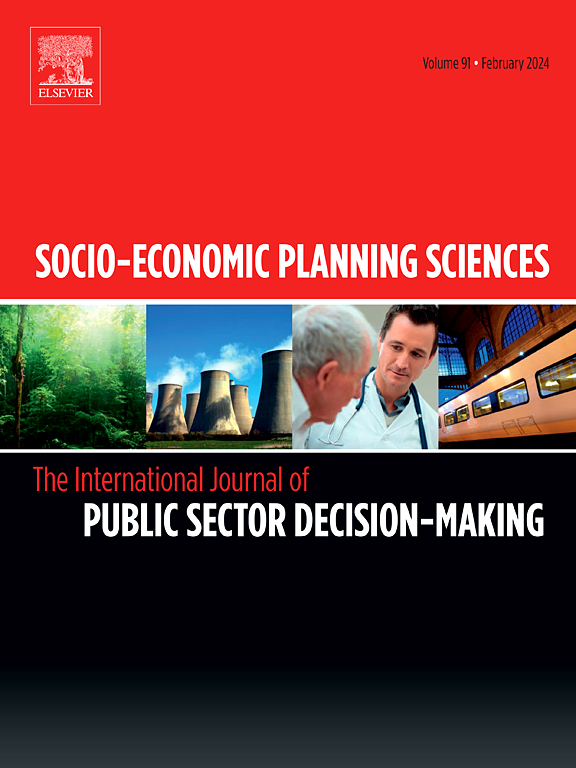Resolving stakeholder conflicts in high-speed railway route planning: An overlapping network and evolutionary game approach
IF 5.4
2区 经济学
Q1 ECONOMICS
引用次数: 0
Abstract
The planning of high-speed railway corridors in ecologically sensitive areas faces significant challenges. Stakeholder conflicts arising from multi-objective conflict often induce decision-making impasses and project delays. Effectively identifying pivotal decision makers and facilitating consensus constitutes a critical challenge. This study first applied the Lancichinetti–Fortunato method to stakeholder relationship networks, detecting overlapping communities that revealed two distinct decision-maker categories: overlapping and non-overlapping decision makers. Subsequently, the most conflicted subgroup pairs and decision-maker dyads were identified using decision maker weights and community weights. To resolve decision conflicts during the consensus-building, a two-party evolutionary game model was constructed to examine strategic interactions between overlapping and conflicting decision makers. Finally, a consensus adjustment method based on the decision makers of the largest conflict is proposed to determine the final solution choice. Sensitivity analysis of the evolutionary game revealed that public attention significantly drives strategic shifts for both overlapping decision makers and conflicting decision makers. In contrast, moral hazard losses only regulate strategy evolution speed without altering direction. Additionally, the conflict intensity between construction and ecological spaces exerts opposing regulatory effects on the two groups’ strategic choices. This study provides theoretical foundations for managing non-cooperative behavior and achieving consensus equilibrium among heterogeneous subgroups.
解决高速铁路线路规划中的利益相关者冲突:一个重叠网络和进化博弈方法
生态敏感区高速铁路廊道规划面临重大挑战。多目标冲突引发的干系人冲突往往会导致决策陷入僵局和项目延误。有效地确定关键决策者和促进协商一致是一项重大挑战。本研究首先将Lancichinetti-Fortunato方法应用于利益相关者关系网络,发现重叠社区揭示了两种不同的决策者类别:重叠决策者和非重叠决策者。随后,使用决策者权重和社区权重确定冲突最严重的子群体对和决策者二对。为了解决共识构建过程中的决策冲突,本文构建了一个两方演化博弈模型来考察重叠和冲突的决策者之间的战略互动。最后,提出了一种基于最大冲突的决策者共识调整方法来确定最终的解决方案选择。进化博弈的敏感性分析表明,公众关注对重叠和冲突决策者的战略转移都有显著的驱动作用。相反,道德风险损失只调节策略演化的速度,而不改变策略演化的方向。此外,建筑与生态空间的冲突强度对两个群体的战略选择产生了相反的调节作用。本研究为管理非合作行为和实现异质子群体间的共识均衡提供了理论基础。
本文章由计算机程序翻译,如有差异,请以英文原文为准。
求助全文
约1分钟内获得全文
求助全文
来源期刊

Socio-economic Planning Sciences
OPERATIONS RESEARCH & MANAGEMENT SCIENCE-
CiteScore
9.40
自引率
13.10%
发文量
294
审稿时长
58 days
期刊介绍:
Studies directed toward the more effective utilization of existing resources, e.g. mathematical programming models of health care delivery systems with relevance to more effective program design; systems analysis of fire outbreaks and its relevance to the location of fire stations; statistical analysis of the efficiency of a developing country economy or industry.
Studies relating to the interaction of various segments of society and technology, e.g. the effects of government health policies on the utilization and design of hospital facilities; the relationship between housing density and the demands on public transportation or other service facilities: patterns and implications of urban development and air or water pollution.
Studies devoted to the anticipations of and response to future needs for social, health and other human services, e.g. the relationship between industrial growth and the development of educational resources in affected areas; investigation of future demands for material and child health resources in a developing country; design of effective recycling in an urban setting.
 求助内容:
求助内容: 应助结果提醒方式:
应助结果提醒方式:


